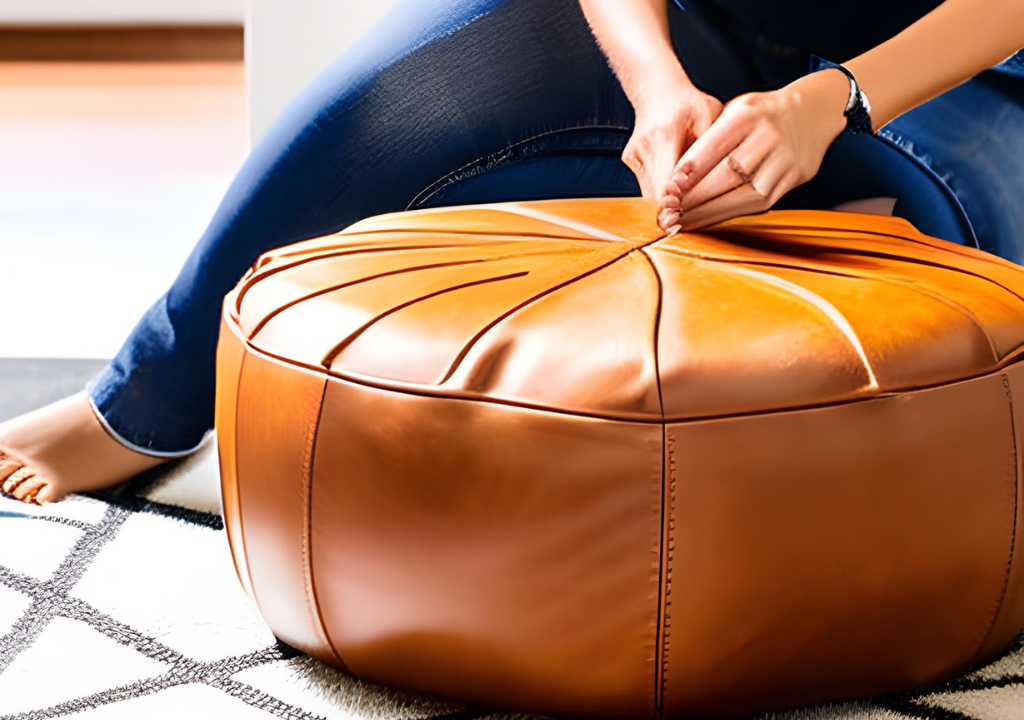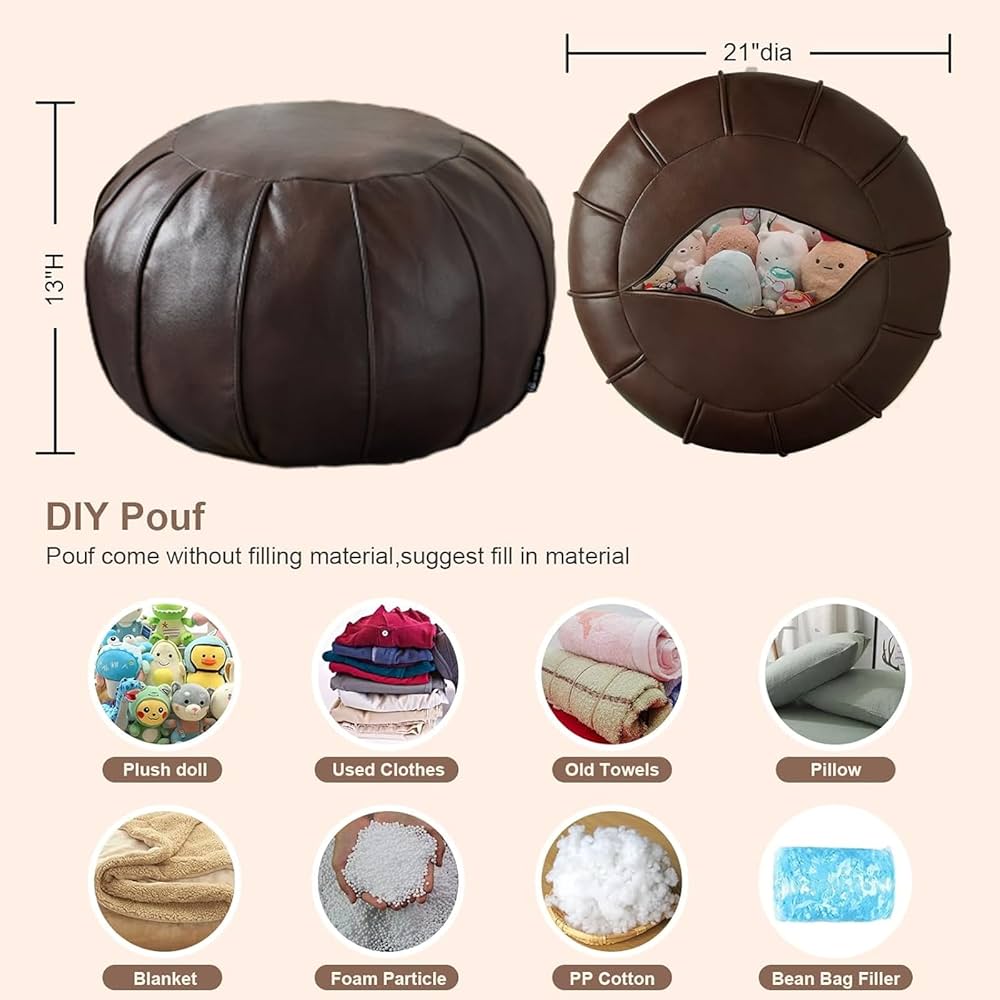Have you ever wondered what goes inside a Moroccan pouf? If you have one or are thinking about getting one, knowing what to put inside can make all the difference.
The right filling not only shapes your pouf but also affects its comfort and durability. You’ll discover simple, practical options that can transform your pouf into a cozy, stylish spot in your home. Keep reading to find out exactly what you should put in your Moroccan pouf to get the best results.
Types Of Filling Materials
Choosing the right filling for a Moroccan pouf affects comfort and durability. Different materials offer various benefits. Some fillings are soft and flexible, while others provide firm support. Understanding the types of filling helps pick the best option for your needs and style.
Natural Fillings
Natural fillings come from organic sources. They feel soft and breathe well. Common natural fillings include:
- Wool – warm and resilient
- Cotton – lightweight and soft
- Feathers – plush and cushy
- Kapok – a fluffy fiber from seed pods
These fillings give a cozy, earthy vibe. They are biodegradable and eco-friendly. Natural fillings may need occasional fluffing to keep shape.
Synthetic Fillings
Synthetic fillings use man-made materials. They often last longer and resist moisture. Popular synthetic fillings are:
- Polyester fiberfill – soft and affordable
- Foam beads – moldable and supportive
- Memory foam – contours to the body
These fillings keep their form well. They are easy to clean and maintain. Some synthetic options provide firmer seating.
Recycled Options
Recycled fillings reuse materials to reduce waste. They offer an eco-conscious choice. Examples include:
- Shredded fabric scraps – soft and flexible
- Recycled foam – supportive and durable
- Plastic pellets – lightweight and moldable
Recycled fillings promote sustainability. They vary in texture and firmness. These options help reduce environmental impact.

Credit: medium.com
Benefits Of Different Fillings
Choosing the right filling for your Moroccan pouf can transform not only its look but also your experience using it. Different fillings offer unique benefits that affect comfort, durability, and even how eco-friendly your pouf is. Understanding these advantages helps you pick a filling that suits your lifestyle and personal preferences.
Comfort And Support
Fillings like shredded foam or polyester fiber provide a soft and cushy feel that molds to your body, making them ideal for lounging. If you want firmer support, natural fillings like wool or cotton tend to hold their shape better and offer steadier seating.
Think about how you plan to use your pouf. Do you want it mainly for resting your feet, or as an extra seat for guests? Your choice of filling can make all the difference in how comfortable it feels in everyday use.
Durability And Longevity
Some fillings last longer than others. For example, high-density foam retains its shape over time, resisting flattening and sagging. On the other hand, beads or pellets might compress faster but allow easy refilling or adjustment.
Durability also depends on how often you use the pouf and the environment it’s in. Are you placing it in a high-traffic area? Selecting a filling that can endure regular use can save you from frequent replacements.
Eco-friendly Choices
Natural materials like wool, cotton, or recycled fabrics offer sustainable alternatives to synthetic fillings. They are biodegradable and often come from renewable sources, reducing environmental impact.
Some people prefer eco-friendly fillings not just for the planet but because they are less likely to cause allergies or off-gassing odors. Could choosing a natural filling improve your indoor air quality and health?
How To Choose The Right Filling
Choosing the right filling affects comfort and shape of a Moroccan pouf. Common options include foam, polyester fiber, or old clothes. Each filling type offers different firmness and support to suit your needs.
Choosing the right filling for a Moroccan pouf can make all the difference in terms of comfort, durability, and aesthetics. It’s not just about stuffing it with any available material; it’s about selecting the best option that suits your lifestyle and needs. Let’s delve into some essential factors to consider when deciding on the perfect filling for your Moroccan pouf.Consider Usage And Placement
Think about where and how you plan to use your pouf. If it’s for a high-traffic area like the living room, you might want something durable and firm, like dense foam or cotton batting. These materials hold their shape well and provide good support for seating. For a more decorative piece in a bedroom or reading nook, softer fillings such as polyester or bean bag beads might be ideal. They offer a plush, comfortable feel perfect for lounging. Ask yourself: Is the pouf mainly for sitting, or will it double as a footrest or side table?Assessing Budget And Quality
Your budget will play a significant role in your decision. High-quality fillings like memory foam can be more expensive but offer superior comfort and longevity. If you are on a tighter budget, consider using recycled materials or fabric scraps, which are cost-effective and environmentally friendly. Weigh the cost against the benefits. Is a higher initial investment worth the long-term comfort and durability?Safety And Allergies
Safety should never be overlooked, especially if you have children or pets. Ensure the filling material is non-toxic and safe for all family members. Polyester and bean bag beads are generally safe options. For those with allergies, hypoallergenic materials are a must. Cotton or synthetic alternatives designed to repel allergens can be a lifesaver. Are you aware of any allergies in your household that could be affected by the filling material?
Credit: www.boucherouiterug.com
Step-by-step Filling Process
Filling a Moroccan pouf correctly is key to its comfort and style. This process shapes the pouf and makes it ready for use. Follow each step carefully to get the best results.
Preparing The Pouf Cover
Start by laying the pouf cover flat on a clean surface. Check for any tears or weak seams. Make sure the zipper or opening is fully open. This helps fill the pouf easily and evenly.
Adding The Filling Material
Choose the filling material based on desired firmness. Common options include foam beads, shredded foam, or old cushions. Use small amounts at first to avoid overfilling. Fill the pouf by scooping the material inside. Spread it evenly to cover all corners.
Shaping And Adjusting
Close the zipper or opening partially after some filling. Press and mold the pouf to form a round shape. Add or remove filling to reach the perfect firmness. Make sure the surface feels smooth and even. Finish by securely closing the pouf cover.
Maintaining And Refilling Your Pouf
Maintaining and refilling your Moroccan pouf keeps it comfortable and looking fresh. Over time, the filling inside the pouf compresses or shifts. This affects its shape and support. Regular care ensures the pouf stays soft and inviting. Refilling restores its fullness and usability. Cleaning protects the fabric from dirt and stains. Together, these tasks extend the life of your pouf.
Signs It’s Time To Refill
- The pouf feels flat or lumpy.
- It no longer holds its shape well.
- The surface feels hard or uneven.
- You notice gaps or empty spots inside.
- It sinks too much when you sit on it.
Tips For Easy Refilling
- Use lightweight fillings like shredded foam or polyester fiber.
- Remove the pouf cover carefully before refilling.
- Fill small amounts at a time for even support.
- Fluff the filling to avoid clumps and lumps.
- Close the cover securely to keep filling inside.
- Consider using a funnel or scoop for precise filling.
Cleaning And Care
Spot clean spills immediately with a damp cloth. Avoid harsh chemicals that may damage fabric. For deeper cleaning, follow care labels on your pouf. Vacuum regularly to remove dust and dirt. Air out the pouf to keep it fresh. Store in a dry place to prevent mold and mildew. Proper cleaning preserves colors and fabric texture.

Credit: www.marrakeche.com
Frequently Asked Questions
What Materials Are Best For Filling A Moroccan Pouf?
Common fillers include polystyrene beads, foam, or old clothes. Polystyrene beads are lightweight and moldable. Foam provides firmness and durability. Using old clothes is eco-friendly and budget-friendly. Choose based on comfort, weight, and intended use of the pouf.
Can I Use Natural Fillers In A Moroccan Pouf?
Yes, natural fillers like wool, cotton, or dried beans can be used. They offer eco-friendly and breathable options. However, natural fillers may compress over time. They are ideal for decorative or light-use poufs rather than heavy-duty seating.
How Much Filling Does A Moroccan Pouf Require?
A typical Moroccan pouf requires about 5 to 8 pounds of filler. The exact amount depends on pouf size and desired firmness. Overfilling can make it hard and uncomfortable. Underfilling results in a soft, less supportive pouf.
Are Polystyrene Beads Safe For Moroccan Pouf Filling?
Yes, polystyrene beads are safe and popular for pouf filling. They are lightweight, moldable, and provide good support. Ensure beads are securely contained to prevent spills. This filler type is ideal for easy shaping and comfort.
Conclusion
Choosing the right filling for a Moroccan pouf affects its comfort and look. Natural materials like cotton or wool make it soft and cozy. Some people prefer foam for extra support. You can also use old clothes or fabric scraps to save money.
Remember to fill it tightly for a nice shape. The filling you pick should match your style and needs. This way, your pouf will stay comfortable and stylish for years. Simple steps, great results.





